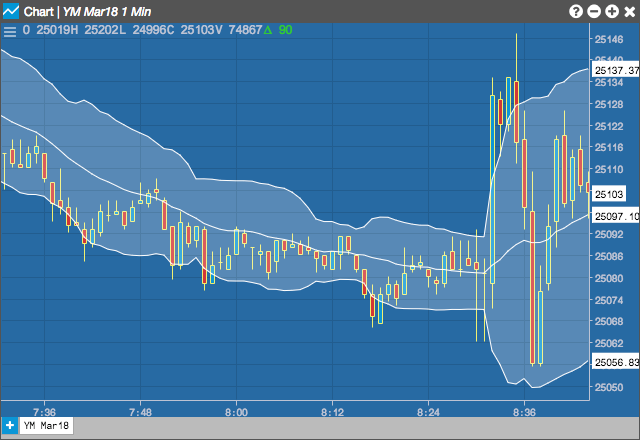チャート
ボリンジャー バンド (BB)
ボリンジャー バンド (BB、Bollinger Band) は、ジョン・ボリンジャー (John Bollinger) が考案した分析手法で、銘柄の移動平均線を中央に、上部と下部にエンベロップを描線します。バンド幅は、終値の移動平均からの標準偏差に基づいています。

Configuration Options

- 欄: 平均計算のベースに使用する価格、または価格の組み合わせ。以下の値があります。
- Open (始値)
- High (高値)
- Low (安値)
- Close (終値)
- Adjusted Close (調整終値)
- HL/2 \( \left ( \frac{High + Low}{2} \right ) \)
- HLC/3 \( \left ( \frac{High + Low + Close}{3} \right ) \)
- HLCC/4 \( \left ( \frac{High + Low + Close + Close}{4} \right ) \)
- OHLC/4 \( \left ( \frac{Open + High + Low + Close}{4} \right ) \)
- Period (ピリオド): 計算で使用されるバー数。
- Standard Deviations (標準偏差): バンドを描画する平均より上と下の標準偏差数。
- Moving Average Type: Type of moving average to use in the calculations:
- Simple: Mean (average) of the data.
- Exponential: Newer data are weighted more heavily geometrically.
- Time Series: Calculates a linear regression trendline using the “least squares fit” method.
- Triangular: Weighted average where the middle data are given the most weight, decreasing linearly to the end points.
- Variable: An exponential moving average with a volatility index factored into the smoothing formula. The Variable Moving average uses the Chande Momentum Oscillator as the volatility index.
- VIDYA: An exponential moving average with a volatility index factored into the smoothing formula. The VIDYA moving average uses the Standard Deviation as the volatility index. (Volatility Index DYnamic Average).
- Weighted: Newer data are weighted more heavily arithmetically.
- Welles Winder:The standard exponential moving average formula converts the time period to a fraction using the formula EMA% = 2/(n + 1) where n is the number of days. For example, the EMA% for 14 days is 2/(14 days +1) = 13.3%. Wilder, however, uses an EMA% of 1/14 (1/n) which equals 7.1%. This equates to a 27-day exponential moving average using the standard formula.
- Hull: The Hull Moving Average makes a moving average more responsive while maintaining a curve smoothness. The formula for calculating this average is as follows: HMA[i] = MA( (2*MA(input, period/2) – MA(input, period)), SQRT(period)) where MA is a moving average and SQRT is square root.
- Double Exponential: The Double Exponential moving average attempts to remove the inherent lag associated to Moving Averages by placing more weight on recent values.
- Triple Exponential: TBD
- Simple
- Exponential
- Time Series
- Triangular
- Variable
- VIDYA
- Weighted
- Welles Winder
- Hull
- Double Exponential
- Triple Exponential
- Channel Fill (チャネル フィル): 上部バンドと下部バンド間の部分を網掛け表示するかどうかを決定します。
- Color Selectors (配色セレクター): グラフ要素に使用する配色。
- Display Axis Label (軸ラベルの表示): Y 軸に最新値を表示するかどうか。
数式
\[Middle\;Band = n\text{-}period\;moving\;average\]
\[Upper\;Band = Middle\;Band\;+\;\left ( y \times n\text{-}period\;Standard\;Deviation\right ) \]
\[Lower\;Band = Middle\;Band\;-\;\left ( y \times n\text{-}period\;Standard\;Deviation\right ) \]
該当:
\[ Standard\;Deviation = \sqrt{d}\]
と
\[ d = \frac{(P_{1}-MA)^{2}+(P_{2}-MA)^{2}+...+(P_{n}-MA)^{2}}{n}\]
該当時
\[ P_{n} =\;the\;user\;defined\;bar\;value\;of\;the\;n^{th}\;bar\]
\[ MA =\;the\;user\;defined\;n\text{-}period\;moving\;average\]